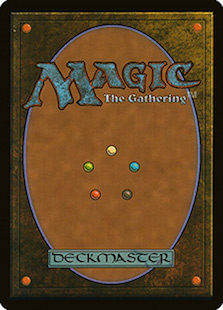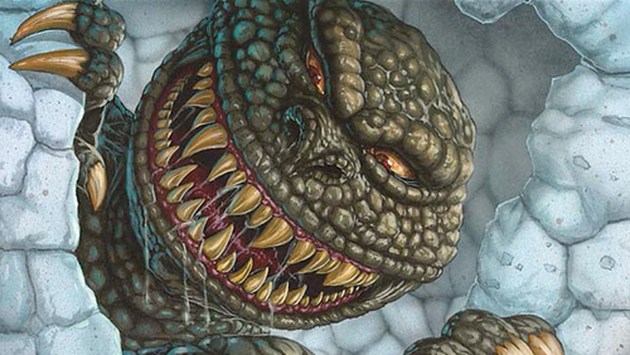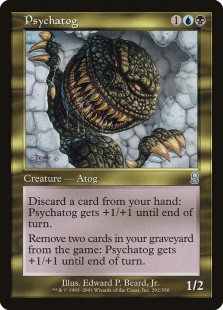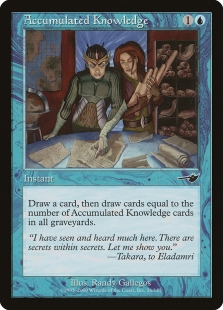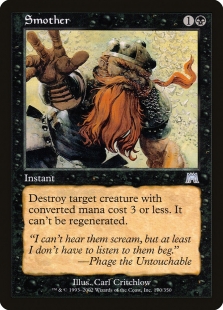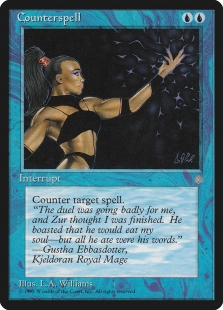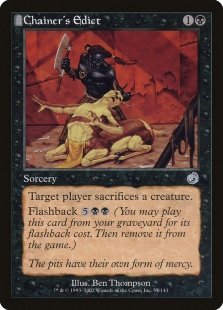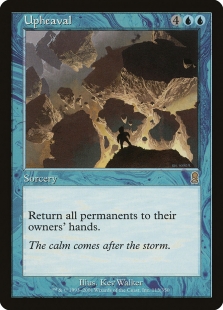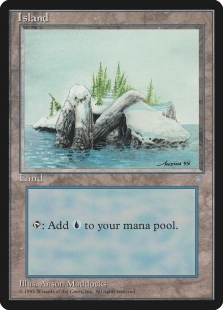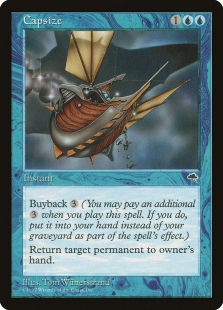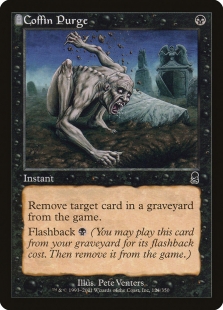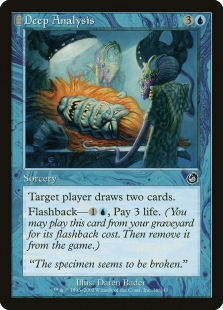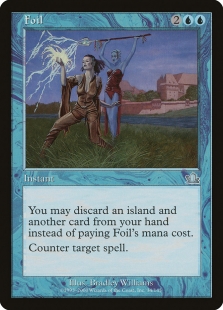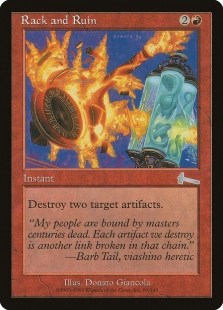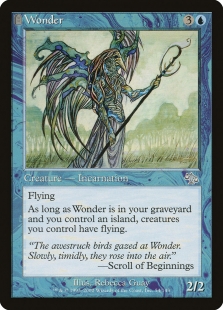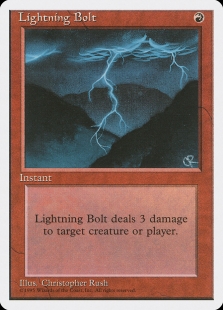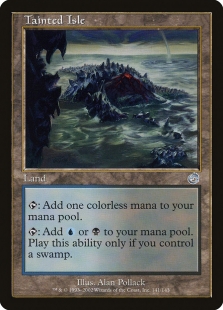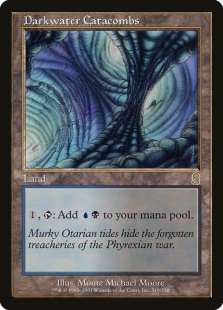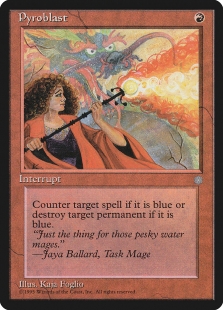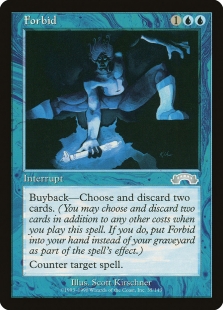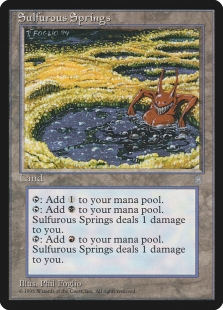Today we have a guest post from Iñaki Puigdollers from Barcelona, Spain. If you’re in the International Premodern Facebook group, you might have noticed his deck techs and reports from their weekly tournaments, which are held at the store Ingenio. In this post, he digs deeper into the Psychatog archetype. Enjoy! / Martin
The importance of a playgroup
It all started by end of March 2018, when a good friend of mine shared with me the link to this website. My first reaction was: “I want to play Extended again!”, but later I realized that it would be a lot more exciting than just that. I’ve been, like most of us, playing Magic in and out for several years but lately I was focused on Old School 93/94, until I came across Premodern. It seems that I have a clear preference for NONO formats (NOstalgic Non-Official).
I started sending whatsapps here and there and some people answered the call starting to create a snowball effect that ended up in a mid-size community (around 20 people) interested in Premodern. A couple of months later we convinced a local store (InGenio) to start running tournaments. How could they deny having Psychatogs, Survival of the Fittest and Goblin Lackeys running rampant over the board once again!?
And there I found myself, full of excitement but no idea on how to start, so I did what I always do: document myself. I started digging through the website to understand how were the different Extended metagames that comprised 1995–2003. After filtering out all the unplayable ideas due to the limitations of this “new version of Extended”, namely all decks that depend enormously on currently banned cards or out-of-the-format like Miracle Gro, I set my eye on three decks: Hatred, Trix and Psychatog. I could write four-page articles for all three decks but today I’ll focus on the latter because with that deck I almost gave up and I’ve been on the brink of qualifying it for completely useless after several iterations, but with my last effort I found a formula that worked!
Before moving forward, I want to say that making this deck work wouldn’t been possible without the help of my playgroup. In particular, three good friends that helped me, every one in his own way, developing the final deck list. Thanks Alex, Ignasi and Xavi!
Lessons from the past
This was the first thing I did to start inspiring myself.
![]()
I found lots of decklists that performed very well during the Extended seasons. Of course, some of them do not really apply for what I was looking for (e.g. all the ‘Tog-Scepter lists). All those lists were mainly split into UB and UBR lists. This was my first important decision. Going two-color seemed more sound and robust, especially in an environment without the original dual lands, but Fire // Ice and Pyroblast are both very strong cards. Moved partially by my love for the UB combination and partially because I always loved solid mana bases I decided to go with the two-color build and started studying the following lists:
Masters 2003 Yokohama: Eugene Harvey 12 Island 4 Polluted Delta 3 Swamp 4 Underground River 4 Psychatog 4 Accumulated Knowledge 4 Brainstorm 4 Counterspell 3 Cunning Wish 1 Deep Analysis 3 Fact or Fiction 2 Intuition 3 Mana Leak 4 Smother 1 Thwart 3 Duress 1 Upheaval Sideboard 2 Annul 1 Capsize 1 Corpse Dance 2 Deep Analysis 1 Diabolic Edict 1 Fact or Fiction 1 Mana Short 4 Powder Keg 1 Shadow Rift 1 Vampiric Tutor
Pro Tour Houston 2002: Peter Myrvig 13 Island 4 Polluted Delta 2 Swamp 4 Underground River 4 Psychatog 1 Wonder 4 Accumulated Knowledge 3 Boomerang 4 Brainstorm 4 Counterspell 2 Cunning Wish 3 Fact or Fiction 4 Force Spike 3 Intuition 4 Memory Lapse 1 Upheaval Sideboard 3 Annul 1 Diabolic Edict 4 Engineered Plague 1 Fact or Fiction 2 Gainsay 1 Hibernation 1 Misdirection 1 Teferi's Response 1 Turnabout
Grand Prix Seattle 2005: Taylor Putnam 16 Island 4 Polluted Delta 3 Swamp 4 Psychatog 4 Accumulated Knowledge 3 Brainstorm 4 Counterspell 4 Cunning Wish 2 Fact or Fiction 3 Foil 3 Gush 4 Intuition 2 Mana Leak 4 Sapphire Medallion Sideboard 1 Brain Freeze 1 Capsize 1 Coffin Purge 1 Dominate 1 Echoing Truth 3 Energy Flux 3 Engineered Plague 1 Fact or Fiction 1 Ghastly Demise 1 Rebuild 1 Shadow Rift
What all three decks have in common is:
- Kill with Psychatog
- Heavy countermagic
- Draw lots of cards
- Play Cunning Wish
Regarding the kill there did not seem to be a consensus. Some used Upheaval to set up for lethal, some others prefered to use some sort of evasion like Wonder or Cunning Wish for Shadow Rift and the last one even had the possibility of a storm kill with Brain Freeze!
Putnam’s list was the most appealing one at first sight. Playing cards like Gush, Sapphire Medallion and Brain Freeze was something hard to overlook but at first glance it seemed weaker and more metagame dependent so I decided to go more along the lines of Myrvig’s and Harvey’s lists.
The learning curve
With all the knowledge I had gathered, this was the first deck I put together:
I had a solid gameplan:
- Deny my opponent’s game until turn 10
- Play Upheaval
- Play a land
- Play Psychatog
- Force Spike/Circular Logic their Swords to Plowshares
- Profit!
I had the means to do it: plenty of lands and card draw, some removal, LOTS of countermagic and flexible Cunning Wish board. Let me do a small parenthesis here to explain some of the Wish-board choices:
- Fact or Fiction: this is normally the first target you do with a Wish. Turn 3 Cunning Wish into Turn 4 Fact or Fiction is a very solid play.
- Diabolic Edict: panic removal solution that may help handling big threats
- Coffin Purge: seemed like the best instant option for graveyard control.
- Shadow Rift: alternate way to get the damage through, it can speed up the kill which is very important against aggro decks
- Corpse Dance: Helped in two ways. It’s good against decks with lots of removal but you can also use it to find Psychatog with Intuition and reanimate it for the win.
Initial testing showed that the list was working really well! I won more than I lost until…. The metagame started to develop and more refined, faster and well rounded aggro decks came to the scene. Goblins and Fires of Yavimaya decks crushed me badly, Survival of the Fittest out-valued me easily, black-based aggro decks out-tempoed me, Swords to Plowshares started to appear everywhere, and it seemed that I could only win against really slow decks like Enchantress or Landstill.
On my journey to find a solution I remembered that some people played a red splash in their ‘Tog lists. Red seemed like the perfect addition to fight aggro, in particular due to Fire // Ice! You can kill early threats, do 2-for-1’s and in the late game it might help Psychatog come through by tapping potential blockers, plus it cycled itself. Red also gave me access to Pyroblast but most importantly, it gave me and amazing card that solved one of the biggest issues of the deck: Fling. With Fling I could just sit and wait until I had a combo kill (with Psychatog + Cunning Wish), and it also solved the problem of Swords to Plowshares, as I could cast Fling at instant speed in response. Finally, red gave me Pyroclasm to fight the aggro threat.
With all this info I decided to cut the Upheaval (Fling seemed like an easier and faster kill). By cutting Upheaval, I no longer needed to ramp lands until turn 10, so I decided to add some Gushes in, as the tempo loss was less relevant. By adding Gush, Fact or Fiction became a bit worse because having four mana to cast it (or six to cast it protected) seemed a bit harder, so I cut those as well and added a couple of Deep Analysis (which are synergic with Intuition). In the sideboard I added Foil as the countermagic of choice as it seemed good with Gush. So I came up with this new iteration:
I happily sat in front of my Goblin opponent to start testing the deck and the result was discouraging… I lost way more games than I won, I couldn’t understand what was going on. Even sideboarded games with my 3x Pyroclasm! Goblins trampled ruthlessly over me. I solved nothing and, what is more critical, I started losing more games against slow control decks. What happened?
Premodern is not Extended
Well, what happened is that I started to realize that Premodern is not Extended, for the following reasons.
We don’t have dual lands
Playing three colors in Premodern is not impossible, but you have to understand some rules if you want to go that route.
- Focus on one primary color. You can also use two primary colors if they are friendly colors. The third color should be a splash or solve specific problems you might find in the mid game.
Your early game cards have to be of the primary color(s). For instance, in the case of my Psychatog deck, the primary color was blue but I needed to have access to red and black if I wanted to survive the early game. This created an impossible-to-solve puzzle with hands holding: Counterspell, Fire // Ice and Terminate, cards that I wanted to be able to play always in turn 2. - Embrace colorless mana. I know Counterspell is an amazing card, but if you can’t cast it then it has the same effect as not having it in the deck. In decks with three or more colors you should consider Mana Leak as superior countermagic than Counterspell
- Consider playing black. Why? Because tainted lands (e.g. Tainted Isle) are very good in multicolored decks. Most people tend to think that painlands are Premodern duals and, while this might be true if you play an aggressive deck that can happily use life as a resource, this does not apply to slow control or midrange decks. The life loss from pain lands is very relevant in this format. My advice is try not to exceed four painlands (and try to minimize them).
The metagame is different
Card legality in Premodern is very different to every single Extended season in the past. Not having access to Force of Will, for instance, puts blue mages in a very awkward position against a Goblins player. Another difference is that most of the powerful and fast combo strategies are not possible either, which means that people has more room for developing fair aggressive creature decks.
When you build a deck you need to understand what you are going to fight against. You cannot simply put together a pile of amazing synergic cards and expect them to win you the game. Adapting your card selection and strategy to your opponents is key for success. And I’m not talking only about the sideboard, which of course helps, but I mean that certain strategies just won’t work in some environments. We have lots of examples of this in the history of Magic—if you’ve played Legacy you might e.g. remember what happened to Storm Combo when Mental Misstep was printed.
For this reason, whenever I build a Premodern deck I try to have in mind how I would win against what I consider the tier 1 decks of the format. In no particular order:
- Goblins
- Landstill
- Enchantress
- Sligh
The list above is based on my personal opinion and experience, and it does not mean that those are the only good decks in the format. However, what they have in common is: They are among the strongest representatives of their archetypes (e.g. Goblins among aggro decks). They are streamlined decks which do only one thing very well, so they are not forgiving and redundant. They cover almost all the spectrum of potential ways to win: attack with creatures, control until you set an unbeatable lethal, prison disabling all possible outs of the opponent and direct damage to the face.
The problem with my Psychatog iteration was that it was unable to beat Goblins. Goblins has a 1/3 chance of drawing Goblin Lackey in the opening hand, and my opponent has a 1/2 chance of going first. This means that on average, 1/6 games I will need a turn one answer to Goblin Lackey (and remember it had to be of my primary color!), and I had none. Moreover, cutting Upheaval meant losing my win condition against Enchantress. So all in all, I made my deck worse against half of the field, good job! 🙂
Almost giving up
I really wanted to make Psychatog work and I tried really hard. I tried versions with Burning Wish (trying to solve the Goblins problem having access to Pyroclasm in Game 1). Too slow.
I tried adding Pyroclasms main deck. It was more or less like having Fire // Ice and I made the control and the Sligh match-ups worse.
I tried removing Cunning Wish, but it was not enough either.
I started thinking that Psychatog was simply a bad deck in Premodern, and that there was nothing I could do to make it work. But I decided to give it a last try:
And it worked! I lended the deck to a friend who won a tournament with it 4–0.
Lightning Bolt was the answer! A card that was not available in Extended when Psychatog was played (remember I said Premodern is not Extended?). It was a perfect answer to Goblins and it speeded up the deck by helping the main game plan.
The deck was not perfect, it had lots of problems (for example being three-colored with three primary colors, but at least the matches where you want early black are completely different to the matches where you want early red), but it was way more adapted to Premodern than all initial incarnations.
The best list
I still wanted to make the deck better and wanted to solve the main problems it had, namely color consistency, but I wanted to keep the spirit of this final iteration which was: speed and ability to win against aggro decks while not losing to control and prison.
I also won a tournament 4–0 with this deck. Let me explain it a bit more in depth.
The mana base
The deck is a two-color deck with two primary colors. However, the deck needs a lot of basic Islands to give support to Gush (you may want to be able to Gush in turn 4–5, see below). For this reason having access to as many basic Islands as possible is mandatory. You also want to have access to black mana on turn 1. So we have:
- 13 access to basic Island
- 11 access to black mana on turn 1 (four out of five games you’ll draw one of those on turn 1)
The two Darkwater Catacombs are flexible cards that help to play cards like Mana Leak, Smother, Diabolic Edict, Accumulated Knowledge, Shadowmage Infiltrator and Psychatog.
The game plan
The goal of the deck is to survive until you have a critical mass of cards and a Psychatog that can deal lethal damage. Bear in mind to do an easy math that every card in your hand is +1.5 strength for Psychatog and every card in the graveyard is +0.5 strength.
This might happen often in the late game, after a grindy game of denying and destroying threats together with a Wonder for evasion, but it can happen very fast in turn 4–5 thanks to Gush!
When you draw Gush you have to think: ok I have drawn a +6.5 strength for my Psychatog, is that enough?
Card selection
- Psychatog: you want four of these. Some may argue that three are enough, but the reason why you need four is because you might want to play it on curve against aggressive decks to use it as a wall. Decks without Swords to Plowshares might have very hard time to deal with an early ‘tog. Another reason why you want four is to be able to spare one if needed and still have the possibility of play Intuition and fetch for the lethal one. The last reason why you want four is for redundancy—you don’t want to have lethal set-up in turn 4–6 and not have the ‘Tog available.
- Wonder: it is the most flexible option to make Psychatog come through. It is not the safest nor the strongest. Fling, Upheaval and Shadow Rift are way safer and difficult to disrupt but also more situational. What I like about Wonder over those other ways is the flexibility. You can play a tempo Wonder if needed to apply pressure or block attackers. You can fetch it with Intuition, which is a card you will play anyway (not like Cunning Wish, which needs specific set-up and deck building). Wonder can make Finkel fly and be able to block Hypnotic Specter. All in all it makes it a better and simpler card than the other options.
- Shadowmage Infiltrator (a.k.a. Finkel): he is the sparring partner of the ‘Tog. It goes with the game plan (draw a critical mass of cards), it can be used as a “soft” wall against aggro and he is also a good Swords to Plowshares bait.
- Accumulated Knowledge: nothing particular to say, bread and butter of card draw, great synergy with Intuition.
- Intuition: very flexible tutor. You’ll often play it for 3x Accumulated Knowledge, but besides that, Intuition can help you find the ‘Tog to set-up lethal or even Wonder. In some cases you can also play it to find that land drop you are missing or that counter/Duress that will make you survive.
- Fact or Fiction: I had mixed feelings about this one. I love it being instant and not costing any lives. The competing card for this slot is Deep Analysis which I’m not sure is worse than Fact or Fiction in this deck. I tested both and I’m still undecided. I guess it comes down to your metagame. Deep Analysis might be better in slower metagames.
- Gush: +6.5 strength to Psychatog. If that’s not enough, Gush is an all around solid card that will dig for answers when needed. But, be careful! The tempo loss it provides is very relevant. Before playing a Gush always think about your next three to five potential plays. Playing a Gush that you shouldn’t will cost you lots of games, in fact there is a whole book explaining how to play Gush properly, written by Stephen Menendian!
- Mana Leak: superior to Counterspell here because it gives me the ability to play turn 1 Duress into turn 2 Mana Leak with basic lands.
- Circular Logic: the main function of this card is to protect Psychatog and set-up the kill. However in a deck that draws like this it can also be used as a “hard counter” for three mana.
- Duress: very good card that is often very badly played. People tend to play duress as soon as they draw it just “because they can”. Duress is so powerful that you might want to save it until it will be really useful. Best ways to use duress before you play a threat in that same turn. Sometimes is good to play Duress the turn before due to mana constraints (in the first few turns). And of course it is good to play it early (turn 1 or 2) if your opponent is playing a deck with a non-creature threat that costs 1–2, e.g. Standstill or Survival of the Fittest.
- Funeral Charm: I wanted to have answers to turn 1 Goblin Lackey. This is the best card black can give you for this purpose. It also has the benefit that it’s not a dead card against control decks, when played at the correct timing that discard can be devastating (but it’s not a card you should play for discard as soon as you draw it, be mindful on when you play it and what impact it might have, also being instant is amazing for this). Swampwalk can also come in handy against black based decks 😉 )
- Ghastly Demise: I wanted at least three potential answers to Goblin Lackey and while this depends on having a fetch land (that’s the reason why I play the loner Bloodstained Mire), it seems better that another Funeral Charm or a Vendetta. It will only be worse IF my opponent plays Goblins, IF my opponent has started, IF I don’t draw a fetchland. More than two IFs make the statement invalid. 🙂
- Smother: solid removal, kills most of the threats and what can’t be killed by Smother can be killed by…
- Diabolic Edict
The sideboard
- Nevinyrral’s Disk: it was a last minute addition when I build the UBR list and it fits perfectly in the deck. You don’t play any artifact or enchantment in the main deck. This means that in games two and three your opponent will likely have eliminated all the artifact hate from their deck making the disk even better. The original reason to play the disk was to have a chance against one of your worst pairings (Enchantress), but in the end, it also helps a lot against aggro and gives you an answer to Humility.
- Engineered Plague: did I told you that I have Goblins in mind when I design a Premodern deck? The plagues are also useful against white weenie (they normally play twelve clerics) and some Survival of the Fittest decks (Llanowar Elves, Quirion Ranger and Deranged Hermit are elves).
- Hydroblast: good against Goblins (answers a turn 1 Goblin Lackey) and Sligh.
- Forbid: additional support against control. Great with Finkel and Gush.
- Perish: versus all sort of green aggro decks. Madness, Survival, Fires…
- Lobotomy: the card helps beating control and prison (and combo if it happens to appear). Is just another bomb that clears the way and might eventually win the game on its own.
Are we done?
Is this the end of the road? Are we done?
No. Even though, I’m happy with the list I feel it will need to be tuned depending on that metagame. The sideboard might need some adjustments if you expect a lot of Enchantress. If that is the case, I recommend adding two or three Aura Flux. If on the other hand your playgroup always plays 4C Control and Landstill you might want to add a couple of Back to Basics. And of course adapt your main deck accordingly.
Bonus track
I don’t want to leave you without sharing the last version I want to test out. But, I want to make this clear, I’m not saying the version below is better than any of the other previous versions, in fact I think it is not, but at least it deserved a spot in case you wanted to try it out.
If you arrived all the way here, thank you for reading! 🙂 I hope you enjoy testing the deck. If you do, or if you have any comments or thoughts on this article, please share them with me and others in the Facebook group, to make us all better players of this format.
Until next time! / Iñaki
